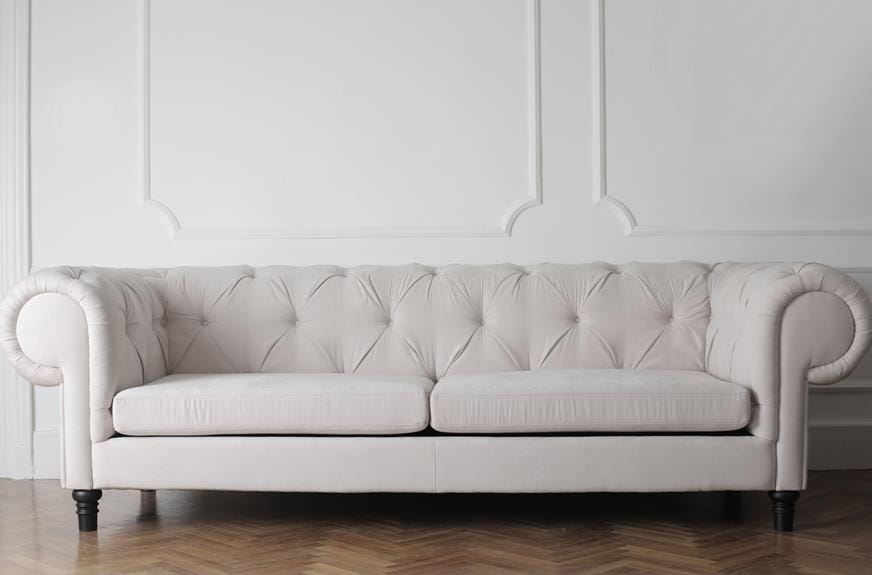Faux leather sofas are prone to peeling because their polyurethane top layer can deteriorate over time. The peeling often results from poor-quality materials, with lower-grade faux leather being more susceptible due to a thinner protective coating and weaker backing. Exposure to sunlight or heat can speed up this deterioration.
Regular use, improper handling, and lack of care can also contribute to peeling. To prevent this, it is important to maintain the sofa with proper cleaning and conditioning.
Quality of Faux Leather
The quality of faux leather directly affects the durability and longevity of sofas made from this material. Faux leather sofas can peel due to the breakdown of the polyurethane coating that mimics the look of genuine leather. This degradation often occurs with low-quality materials, frequent usage, and inadequate care.
Peeling is particularly common in bonded leather, which is made from recycled leather scraps and a smaller amount of polyurethane, leading to a less resilient surface. High-quality faux leathers with a thicker polyurethane layer are more resistant to peeling but can still be affected over time.
Impact of Environmental Factors
Sunlight and heat can damage faux leather sofas by accelerating peeling. UV rays weaken the plasticizers in faux leather, causing it to become brittle and peel. Heat from radiators or vents dries out the material and increases peeling risk.
Peeling often results from hydrolysis, where heat and moisture break down the layers’ bonds. Keeping faux leather furniture in controlled climates and regular cleaning can prevent damage. Mild cleaners should be used, and harsh chemicals avoided to maintain the material’s condition.
If peeling occurs, fabric paints or clear vinyl adhesives can repair minor damage. For extensive peeling, reupholstering might be necessary.
Preventative care, such as proper placement and maintenance, is the best way to prolong the life of faux leather furniture and prevent peeling.
Effects of Wear and Tear
Regular use causes faux leather sofas to experience wear, leading to peeling and flaking. Over time, friction, pressure, and minor damage affect the sofa’s surface, especially in high-use areas, revealing the underlying material. This results in a loss of the sofa’s original color and texture, decreasing its visual appeal and value. If not addressed, the peeling can worsen and spread.
To repair the damage, homeowners can use a faux leather repair kit, which includes color-matched leather paint for a cohesive look. Following the instructions is crucial for a smooth finish when applying the repair kit’s colorant. However, the repaired areas may be less durable than the original material and could peel again.
Regular cleaning with suitable products and protecting the sofa from harsh conditions can help prolong its lifespan. Nevertheless, peeling is an expected part of the aging process for faux leather furniture.
Cleaning and Maintenance Practices
To prevent faux leather sofas from peeling, regularly clean and maintain them with care. Faux leather is less durable than real leather and needs a gentle approach. To fix peeling, start by wiping the surface with a damp cloth to remove loose particles. Then, apply a leather repair solution appropriate for faux leather, matching the sofa’s color.
Allow the repair solution to dry completely before using the sofa. For significant peeling, use color-matched leather paint, following the manufacturer’s instructions and allowing it to dry thoroughly.
Do not use harsh chemicals or abrasive tools, as they can worsen peeling. Use cleaners made for faux leather and condition the sofa regularly to keep it flexible. Protect the sofa from direct sunlight and heat to prolong its life.
Following these steps will reduce the need for repairs and keep the sofa looking good for longer.
Lifespan and Durability Concerns
Faux leather sofas are less durable than genuine leather sofas. Genuine leather comes from animal hides and lasts longer, while faux leather, made from plastic or polyurethane, can degrade with daily use. This can cause the faux leather to peel and expose the underlying fabric.
Moisture can also break down faux leather, making it peel faster. Professional repair services may fix these issues, but it’s not always worth the cost compared to buying a new sofa. Consumers should consider the long-term costs of repairs or replacements when choosing faux leather furniture.
In short, faux leather sofas may be initially cheaper but might not be as cost-effective in the long run due to durability issues.





